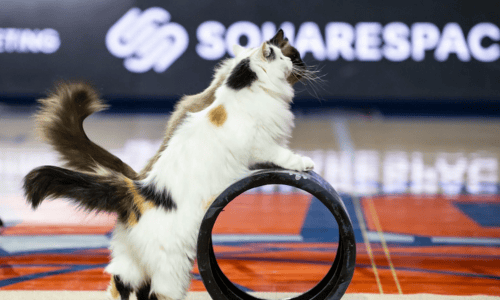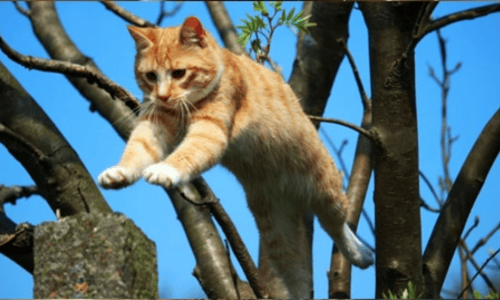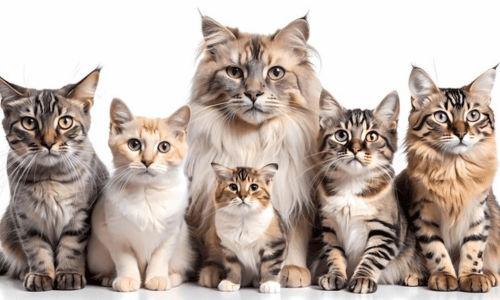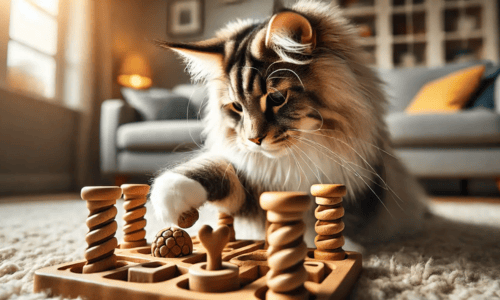Understanding Feline Intelligence
Cats may not fetch the newspaper like dogs or perform complex tricks on command, but they are intelligent creatures. Their intelligence manifests in different ways—some natural, others developed through interaction and training. Let’s take a look at what makes them such skillful animals.
Cats and Their Unique Skillset
Felines have a range of skills that come from their instincts as hunters. These abilities can be channeled into fun and engaging behaviors, both for entertainment and practical purposes. Cats are excellent at learning from their environment, observing patterns, and using their sharp senses to their advantage.
Natural Instincts That Translate into Talents
Much of what we admire about cats—agility, hunting prowess, and problem-solving—stems from their natural instincts. In the wild, these skills are essential for survival, but in the comfort of our homes, they can be nurtured and transformed into incredible talents.
Common Talents in Cats
While every cat is unique, there are several talents that seem to come naturally to most of our feline friends. These can range from impressive physical feats to more subtle forms of communication and problem-solving.

Agility and Balance
Cats are built for agility. Their lithe bodies, sharp claws, and exceptional balance allow them to leap and climb with ease. These natural abilities often leave us amazed at how effortlessly they can navigate through tricky spaces.
Jumping and Climbing
Ever wonder how your cat manages to jump from the floor to the top of a bookshelf in one bound? Cats have powerful hind legs that help them achieve these feats. This talent is rooted in their predatory instincts, as jumping gives them an advantage when stalking prey or escaping threats.
Nimbleness in Tight Spaces
Cats are masters of fitting into tight spaces. Their flexible spines and collarbones allow them to squeeze into areas that seem far too small. This nimbleness helps them explore their surroundings, making them talented little explorers.
Understanding Feline Intelligence
Cats may not fetch the newspaper like dogs or perform complex tricks on command, but they are intelligent creatures. Their intelligence manifests in different ways—some natural, others developed through interaction and training. Let’s take a look at what makes them such skillful animals.
Cats and Their Unique Skillset
Felines have a range of skills that come from their instincts as hunters. These abilities can be channeled into fun and engaging behaviors, both for entertainment and practical purposes. Cats are excellent at learning from their environment, observing patterns, and using their sharp senses to their advantage.
Natural Instincts That Translate into Talents
Much of what we admire about cats—agility, hunting prowess, and problem-solving—stems from their natural instincts. In the wild, these skills are essential for survival, but in the comfort of our homes, they can be nurtured and transformed into incredible talents.
Common Talents in Cats
While every cat is unique, there are several talents that seem to come naturally to most of our feline friends. These can range from impressive physical feats to more subtle forms of communication and problem-solving.
Agility and Balance
Cats are built for agility. Their lithe bodies, sharp claws, and exceptional balance allow them to leap and climb with ease. These natural abilities often leave us amazed at how effortlessly they can navigate through tricky spaces.
Jumping and Climbing
Ever wonder how your cat manages to jump from the floor to the top of a bookshelf in one bound? Cats have powerful hind legs that help them achieve these feats. This talent is rooted in their predatory instincts, as jumping gives them an advantage when stalking prey or escaping threats.
Nimbleness in Tight Spaces
Cats are masters of fitting into tight spaces. Their flexible spines and collarbones allow them to squeeze into areas that seem far too small. This nimbleness helps them explore their surroundings, making them talented little explorers.
Hunting and Stalking Abilities
Even domesticated cats have strong hunting instincts. If you’ve ever seen your cat “hunt” a toy or insect, you’ve witnessed their natural talent for stalking and catching prey.
Catching Prey-Like Toys
Cats love to chase after toys that mimic the movements of their prey. Their ability to judge distances, pounce, and strike with precision is something that can be honed and encouraged with play. It’s not just fun—it’s tapping into their inner hunter.
Precision and Patience
Cats are incredibly patient hunters. When they focus on a target, they’ll wait quietly for the perfect moment to strike. This patience is a talent that many cat owners observe during playtime, and it’s a key part of what makes them such skilled hunters.
Vocal Talents: Meowing, Purring, and Mimicking
Cats are communicative creatures, and their vocal talents go beyond simple meows and purrs. Some cats are even capable of mimicking sounds they hear around the house or communicating specific needs to their humans.
Communicating with Humans
Ever notice how your cat has a particular “meow” when they’re hungry? Or how they purr at just the right time to get your attention? Cats use vocalization as a way of communicating with us. Some cats even develop a more complex vocabulary, tailoring their sounds based on what gets the desired response.
Mimicking Sounds and Commands
A lesser-known talent in some cats is their ability to mimic certain sounds. While it’s not as common as with dogs or birds, some cats can learn to replicate sounds like whistling, knocking, or even human words. With proper encouragement, this vocal skill can become a unique talent.
Problem-Solving Skills
Cats are surprisingly adept at solving problems, especially when it comes to getting what they want. Whether it’s figuring out how to open a door or working their way through a puzzle toy, their intelligence often shines through.
Puzzle Toys and Food Challenges
Puzzle toys are an excellent way to encourage your cat’s problem-solving abilities. Whether it’s figuring out how to retrieve a treat or solving a simple mechanism, cats can show incredible determination and intelligence when faced with a challenge.
Opening Doors and Drawers
Many cat owners can relate to finding their cat in places they’re not supposed to be—like inside a drawer or behind a closed door. Cats can use their paws and claws to manipulate objects in ways that other pets simply can’t. This talent highlights their impressive dexterity and curiosity.
Social Skills: Cat-Owner Interactions
Cats may be independent creatures, but they’re also highly social and can form strong bonds with their owners. Through these interactions, cats can learn various tricks and behaviors that deepen their relationship with humans.
Learning Tricks and Commands
While cats are known for their independence, they can still be trained to perform tricks. Simple commands like “sit,” “come,” or even “high-five” are within reach with the right motivation—usually in the form of treats or affection.
Emotional Sensitivity and Support
Cats are often more emotionally tuned in than we give them credit for. They can sense their owner’s mood and respond accordingly, offering comfort by sitting nearby or purring softly. This sensitivity is a talent that many cat owners appreciate, especially during stressful times.
Uncommon or Extraordinary Talents in Cats
While most cats exhibit common talents, some go above and beyond. These extraordinary skills are often the result of a combination of natural ability and dedicated training.

Fetching Like a Dog
Believe it or not, some cats can be taught to fetch! This is an uncommon talent, but with the right encouragement, a cat can learn to bring back a toy or object just like a dog would.
Walking on a Leash
While most cats prefer to roam freely, some cats can be trained to walk on a leash. This is a great way to give them outdoor time in a controlled environment, and it’s a talent that requires patience and training.
High-Five and Other Paw Tricks
Teaching a cat to give a high-five or shake paws is not as difficult as it sounds. With the right positive reinforcement and consistency, your cat can learn these tricks and impress friends and family.
How to Train and Develop Cat Talents
Now that you’re familiar with the range of talents your cat might have, you may wonder how to bring out these abilities. Training a cat takes patience, but the rewards are worth it.
Positive Reinforcement Techniques
Cats respond best to positive reinforcement, which means rewarding them when they perform the desired behavior. Treats, affection, and praise go a long way in teaching your cat new tricks and encouraging them to showcase their talents.
Patience and Consistency
Training cats requires time and repetition. Unlike dogs, who may learn commands quickly, cats take a little more time. Consistency is key—set aside short, regular training sessions to help your cat learn and grow.
Using Clickers and Treats
Clicker training is an effective method for teaching cats new behaviors. The sound of the clicker marks the correct behavior, followed by a reward. Over time, your cat will associate the click with a treat, making training more efficient.
Benefits of Encouraging Cat Talents
Developing your cat’s talents is not just about entertainment—it can provide several benefits for both you and your feline friend.
Strengthening the Cat-Human Bond
Training and interacting with your cat regularly strengthens your bond. Your cat will start to associate you with positive experiences, leading to a deeper and more fulfilling relationship.
Enhancing Mental Stimulation and Health
Cats need mental stimulation to stay happy and healthy. Encouraging their natural talents through play, training, and problem-solving helps keep their minds sharp and reduces behavioral issues that stem from boredom.
Even domesticated cats have strong hunting instincts. If you’ve ever seen your cat “hunt” a toy or insect, you’ve witnessed their natural talent for stalking and catching prey.
Catching Prey-Like Toys
Cats love to chase after toys that mimic the movements of their prey. Their ability to judge distances, pounce, and strike with precision is something that can be honed and encouraged with play. It’s not just fun—it’s tapping into their inner hunter.
Precision and Patience
Cats are incredibly patient hunters. When they focus on a target, they’ll wait quietly for the perfect moment to strike. This patience is a talent that many cat owners observe during playtime, and it’s a key part of what makes them such skilled hunters.
Vocal Talents: Meowing, Purring, and Mimicking
Cats are communicative creatures, and their vocal talents go beyond simple meows and purrs. Some cats are even capable of mimicking sounds they hear around the house or communicating specific needs to their humans.
Communicating with Humans
Ever notice how your cat has a particular “meow” when they’re hungry? Or how they purr at just the right time to get your attention? Cats use vocalization as a way of communicating with us. Some cats even develop a more complex vocabulary, tailoring their sounds based on what gets the desired response.
Mimicking Sounds and Commands
A lesser-known talent in some cats is their ability to mimic certain sounds. While it’s not as common as with dogs or birds, some cats can learn to replicate sounds like whistling, knocking, or even human words. With proper encouragement, this vocal skill can become a unique talent.
Problem-Solving Skills
Cats are surprisingly adept at solving problems, especially when it comes to getting what they want. Whether it’s figuring out how to open a door or working their way through a puzzle toy, their intelligence often shines through.

Puzzle Toys and Food Challenges
Puzzle toys are an excellent way to encourage your cat’s problem-solving abilities. Whether it’s figuring out how to retrieve a treat or solving a simple mechanism, cats can show incredible determination and intelligence when faced with a challenge.
Opening Doors and Drawers
Many cat owners can relate to finding their cat in places they’re not supposed to be—like inside a drawer or behind a closed door. Cats can use their paws and claws to manipulate objects in ways that other pets simply can’t. This talent highlights their impressive dexterity and curiosity.
Social Skills: Cat-Owner Interactions
Cats may be independent creatures, but they’re also highly social and can form strong bonds with their owners. Through these interactions, cats can learn various tricks and behaviors that deepen their relationship with humans.
Learning Tricks and Commands
While cats are known for their independence, they can still be trained to perform tricks. Simple commands like “sit,” “come,” or even “high-five” are within reach with the right motivation—usually in the form of treats or affection.
Emotional Sensitivity and Support
Cats are often more emotionally tuned in than we give them credit for. They can sense their owner’s mood and respond accordingly, offering comfort by sitting nearby or purring softly. This sensitivity is a talent that many cat owners appreciate, especially during stressful times.
Uncommon or Extraordinary Talents in Cats
While most cats exhibit common talents, some go above and beyond. These extraordinary skills are often the result of a combination of natural ability and dedicated training.
Fetching Like a Dog
Believe it or not, some cats can be taught to fetch! This is an uncommon talent, but with the right encouragement, a cat can learn to bring back a toy or object just like a dog would.
Walking on a Leash
While most cats prefer to roam freely, some cats can be trained to walk on a leash. This is a great way to give them outdoor time in a controlled environment, and it’s a talent that requires patience and training.
High-Five and Other Paw Tricks
Teaching a cat to give a high-five or shake paws is not as difficult as it sounds. With the right positive reinforcement and consistency, your cat can learn these tricks and impress friends and family.
How to Train and Develop Cat Talents
Now that you’re familiar with the range of talents your cat might have, you may wonder how to bring out these abilities. Training a cat takes patience, but the rewards are worth it.
Positive Reinforcement Techniques
Cats respond best to positive reinforcement, which means rewarding them when they perform the desired behavior. Treats, affection, and praise go a long way in teaching your cat new tricks and encouraging them to showcase their talents.
Patience and Consistency
Training cats requires time and repetition. Unlike dogs, who may learn commands quickly, cats take a little more time. Consistency is key—set aside short, regular training sessions to help your cat learn and grow.
Using Clickers and Treats
Clicker training is an effective method for teaching cats new behaviors. The sound of the clicker marks the correct behavior, followed by a reward. Over time, your cat will associate the click with a treat, making training more efficient.
Benefits of Encouraging Cat Talents
Developing your cat’s talents is not just about entertainment—it can provide several benefits for both you and your feline friend.

Strengthening the Cat-Human Bond
Training and interacting with your cat regularly strengthens your bond. Your cat will start to associate you with positive experiences, leading to a deeper and more fulfilling relationship.
Enhancing Mental Stimulation and Health
Cats need mental stimulation to stay happy and healthy. Encouraging their natural talents through play, training, and problem-solving helps keep their minds sharp and reduces behavioral issues that stem from boredom.












